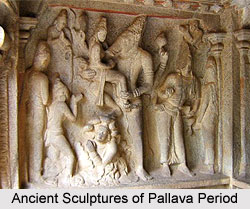 Religion was most pervasive during the Pallava period. The Jains and the Buddhists seem to have become powerful and entrenched in royal courts during the fag end of the Kalabhra period. Therefore, Saivism of the early 7th century A.D. became quite aggressive and fought out the issue with the heretics.
Religion was most pervasive during the Pallava period. The Jains and the Buddhists seem to have become powerful and entrenched in royal courts during the fag end of the Kalabhra period. Therefore, Saivism of the early 7th century A.D. became quite aggressive and fought out the issue with the heretics.
Owing to the conflicts between the Saivites and the other religious sects the entire Pallava period was preparatory to that consummation which was to come after Sankara. The Pallava family worshipped different Gods at different times. Mahendravarman was first a Jaina and then a Saiva, Paramesvaravarman was a Saiva, Rajasimha`s name was Narasimhavarman (quite common among the Pallavas) but he built a temple for Kailasanatha (Siva). Nandivarman whose earlier name was Paramesvara built a temple for Vaikuntha Perumal (Vishnu). This certainly is different from the religious affiliation which characterized the Cholas from Aditya I to Kulottunga II, which was nearly fanatical Saivism.
The Bhakti movement is the name generally given to the activities of the Alvars and the Nayanmars. The movement itself achieved the sophistication of these two Hindu sects especially the Saivite. The Kalamukhas and the Pasupatas were two ferocious primitive Saivite sects, which indulged in orgies including human sacrifice. The Nayanmars created a sophisticated type of Bhakti Saivism whose chief slogan was `love is Siva`. They had to fight on two fronts i.e., while they were reforming the crude sects among themselves they had to deal with the then dominant Jainism and Buddhism while taking care not to forget the potential Vaishnavite hostility.
The two Bhakti streams, however collectively achieved a marvellous new atmosphere of God - consciousness among the people. A straight product of the Bhakti movement was the construction of a number of temples dedicated either to Siva or to Vishnu. It is said that Cholan Senganan caused a number of Siva temples to be constructed in the Chola country. The kings constructed many new temples and some of the older ones were made centres of religious edu cation. Of these the pride of place goes to Chidambaram, which later in Chola times was to become even a secondary capital. The Bhakti movement could be traced back to the Bhagavad Gita that was given a new and monistic interpretation by Sankaracharya of Kaladi. He attempted a philosophical justification of Smartaism.



















